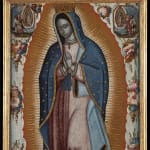BERNARDO POLANCO
Provenance
Private Collection
Our Lady of Guadalupe, according to Mexican tradition, appeared four times to the indigenous Juan Diego Cuauhtlatoatzin, on the hill of Tepeyac. The Virgin commissioned him to ask the capitalist bishop - the Franciscan Juan de Zumárraga - in his name to build a church at the place of the apparition. As the bishop did not accept the idea, the Virgin asked him to insist. The next day, Sunday, Cuauhtlatoatzin found the prelate again, who examined him in Christian doctrine and asked for objective evidence in confirmation of the prodigy.
On December 12, 1531, while Cuauhtlatoatzin was heading back to the city, the Virgin came back to him and comforted him, inviting him to climb to the top of Tepeyac hill to pick flowers and bring them to her. Despite the cold winter season and the aridity of the place, Cuauhtlatoatzin found some very beautiful flowers. Once collected, he placed them in his "tilma" and took them to the Virgin, who ordered him to present them to the bishop as proof of truthfulness. Once before the bishop the saint opened his "tilma" and dropped the flowers while the image of the Virgin of Guadalupe appeared inexplicably printed on the fabric, which from that moment became the spiritual heart of the Church in Mexico .
The saint, moved by a tender and deep devotion to the Mother of God, left his house, property and land and, with the bishop's permission, moved to live in a poor house next to the temple of the « Lady of Heaven ». His concern was the cleanliness of the chapel and the reception of the pilgrims who visited the small oratory, today transformed into a basilica, an eloquent symbol of the Marian devotion of Mexicans to the Virgin of Guadalupe.
This sacred painting caused all painters who wanted to reproduce it to be forced to paint it exactly. From the seventeenth century different elements were added in the corners, such as posters, flowers, angels, or the representation of Juan Diego in the four meetings with the Virgin.



